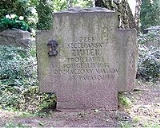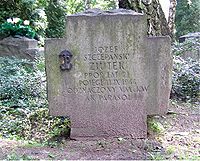
Józef Szczepanski
Encyclopedia

Warsaw
Warsaw is the capital and largest city of Poland. It is located on the Vistula River, roughly from the Baltic Sea and from the Carpathian Mountains. Its population in 2010 was estimated at 1,716,855 residents with a greater metropolitan area of 2,631,902 residents, making Warsaw the 10th most...
) was a Polish poet who was a member of the Armia Krajowa
Armia Krajowa
The Armia Krajowa , or Home Army, was the dominant Polish resistance movement in World War II German-occupied Poland. It was formed in February 1942 from the Związek Walki Zbrojnej . Over the next two years, it absorbed most other Polish underground forces...
Polish resistance
Polish resistance movement in World War II
The Polish resistance movement in World War II, with the Home Army at its forefront, was the largest underground resistance in all of Nazi-occupied Europe, covering both German and Soviet zones of occupation. The Polish defence against the Nazi occupation was an important part of the European...
. Commander of the Batalion Parasol
Batalion Parasol
Battalion Parasol was a Scouting battalion of the Armia Krajowa, the primary Polish resistance movement in World War II. It consisted mainly of members of the Szare Szeregi, distinguishing itself in many underground operations, and in the Warsaw Uprising of 1944 .-...
during the Warsaw Uprising
Warsaw Uprising
The Warsaw Uprising was a major World War II operation by the Polish resistance Home Army , to liberate Warsaw from Nazi Germany. The rebellion was timed to coincide with the Soviet Union's Red Army approaching the eastern suburbs of the city and the retreat of German forces...
, known under his codename Ziutek, he was also a notable poet of the occupation period
Polish culture during World War II
Polish culture during World War II was suppressed by the occupying powers of Nazi Germany and the Soviet Union, both of whom were hostile to Poland's people and cultural heritage. Policies aimed at cultural genocide resulted in the deaths of thousands of scholars and artists, and the theft and...
. Many of his poems were made into songs; the most notable one was "Pałacyk Michla".
Biography
Szczepanski spent his childhood in several places, such as Łęczyca, GrudziądzGrudziadz
Grudziądz is a city in northern Poland on the Vistula River, with 96 042 inhabitants . Situated in the Kuyavian-Pomeranian Voivodeship , the city was previously in the Toruń Voivodeship .- History :-Early history:...
, Jablonna
Jablonna
Jabłonna may refer to the following places:*Jabłonna, Łęczyca County in Łódź Voivodeship *Jabłonna, Radomsko County in Łódź Voivodeship *Jabłonna, Lublin Voivodeship...
and finally, some time in mid-1930s, he moved with the family to Warsaw. During the Polish September Campaign, he fled with parents to Volhynia
Volhynia
Volhynia, Volynia, or Volyn is a historic region in western Ukraine located between the rivers Prypiat and Southern Bug River, to the north of Galicia and Podolia; the region is named for the former city of Volyn or Velyn, said to have been located on the Southern Bug River, whose name may come...
, then moved to Rzeszów
Rzeszów
Rzeszów is a city in southeastern Poland with a population of 179,455 in 2010. It is located on both sides of the Wisłok River, in the heartland of the Sandomierska Valley...
and Dębica
Debica
Dębica is a town in southeastern Poland with 46,693 inhabitants, as of 2 June 2009. It is the capital of Dębica County. Since 1999 it has been situated in the Subcarpathian Voivodeship; it had previously been in the Tarnów Voivodeship .-Area:...
. Finally, some time in the early 1940s, he returned to the capital of Poland. Back in Warsaw, Józef Szczepański continued his education in underground courses
Education in Poland during World War II
This article covers the topic of underground education in Poland during World War II. Secret learning prepared new cadres for the post-war reconstruction of Poland and countered the German and Soviet threat to exterminate the Polish culture....
; interrupted by the German and Soviet attack on Poland. He also joined the Polish resistance (see: Szare Szeregi
Szare Szeregi
"Gray Ranks" was a codename for the underground Polish Scouting Association during World War II.The wartime organisation was created on 27 September 1939, actively resisted and fought German occupation in Warsaw until 18 January 1945, and contributed to the resistance operations of the Polish...
), becoming an officer candidate
Officer Cadet
Officer cadet is a rank held by military and merchant navy cadets during their training to become commissioned officers and merchant navy officers, respectively. The term officer trainee is used interchangeably in some countries...
. He was a member of the squad that attempted to assassinate Nazi official, Wilhelm Koppe
Wilhelm Koppe
Wilhelm Koppe was a German Nazi commander who was responsible for numerous atrocities against Poles and Jews in Reichsgau Wartheland and the General Government during the German occupation of Poland in World War II.-Biography:Born in Hildesheim, he fought in the First World War...
. Szczepanski was the soldier of the 1st Platoon of the 1st Company Agat of the Batalion Parasol, he publicly recited his first poem Dzis ide walczyc - mamo (Today, I am going fighting, mother), on Dec. 31, 1943 in a house at 12 Swietojanska street in Warsaw. Soon afterwards, he became a bard
Bard
In medieval Gaelic and British culture a bard was a professional poet, employed by a patron, such as a monarch or nobleman, to commemorate the patron's ancestors and to praise the patron's own activities.Originally a specific class of poet, contrasting with another class known as fili in Ireland...
of Parasol
During the Warsaw Uprising he was a squad leader in the Batalion Parasol (mostly composed of youths, many of them from Szare Szeregi underground scouting). He took command of the entire unit after its previous commander was killed. Wounded on the same day (1 September) in Warsaw Old Town
Warsaw Old Town
Warsaw's Old Town is the oldest historic district of the city. It is bounded by Wybrzeże Gdańskie, along the bank of the Vistula, and by Grodzka, Mostowa and Podwale Streets. It is one of Warsaw's most prominent tourist attractions....
, he was evacuated by his soldiers to Warszawa-Śródmieście
Warszawa-Sródmiescie
Śródmieście is the central borough of the city of Warsaw. The best known neighborhoods in the borough are the Old Town and New Town ....
but would die on 10 September.
Recipient of the Cross of Valour (twice), and the Virtuti Militari
Virtuti Militari
The Order Wojenny Virtuti Militari is Poland's highest military decoration for heroism and courage in the face of the enemy at war...
(5th class, posthumously
Award
An award is something given to a person or a group of people to recognize excellence in a certain field; a certificate of excellence. Awards are often signifiedby trophies, titles, certificates, commemorative plaques, medals, badges, pins, or ribbons...
).
Poetry
Many of Szczepański's poems became popular in occupied Warsaw, particularly as he used them to chronicle the fights of the Batalion Parasol; some were made into songs. Many were however destroyed during the Uprising; less than 20 survive to this day. His poetry, particularly his poem Red plagueRed Plague (poem)
Red Plague is a Polish poem, written in 1944 by Józef Szczepański, a World War II time poet, who died during the Warsaw Uprising. Red plague inspired Polish Oscar-winning film director, Andrzej Wajda to create the movie Kanał...
, was also one of the things that inspired Polish Oscar-winning film director, Andrzej Wajda
Andrzej Wajda
Andrzej Wajda is a Polish film director. Recipient of an honorary Oscar, he is possibly the most prominent member of the unofficial "Polish Film School"...
, to create the movie Kanał. The poem, which described the failed hopes of Warsaw insurgents that Red Army
Red Army
The Workers' and Peasants' Red Army started out as the Soviet Union's revolutionary communist combat groups during the Russian Civil War of 1918-1922. It grew into the national army of the Soviet Union. By the 1930s the Red Army was among the largest armies in history.The "Red Army" name refers to...
would save them, was banned in the People's Republic of Poland
People's Republic of Poland
The People's Republic of Poland was the official name of Poland from 1952 to 1990. Although the Soviet Union took control of the country immediately after the liberation from Nazi Germany in 1944, the name of the state was not changed until eight years later...
due to its anti-Soviet context; during the Stalin era the very possession of it was punishable by imprisonment.
He is counted among the Generation of Columbuses
Generation of Columbuses
The Generation of Columbuses is a term denoting the entire generation of Poles born soon after Poland regained her independence in 1918, and whose adolescence has been marked by the tragic times of the World War II. The term itself was coined by Roman Bratny in his well-received 1957 novel...
- generation of Polish artists whose lives were dramatically impacted by the Second World War.

